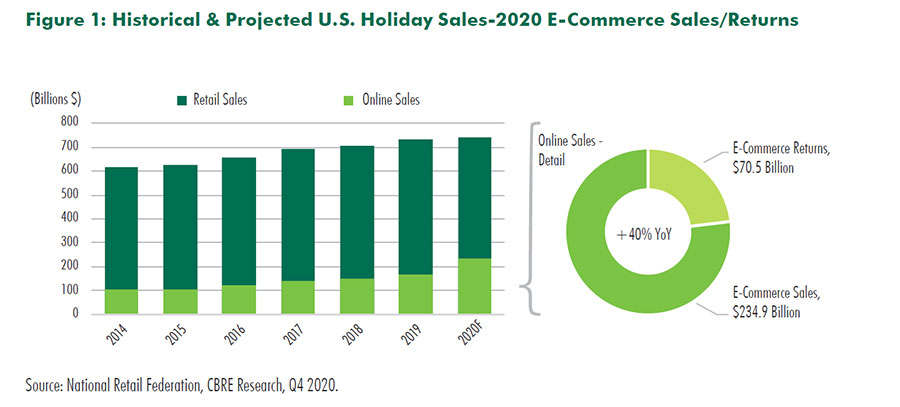When the Los Angeles-based industrial real estate developer CBRE released its report “Reverse Logistics Stress Test: Holiday E-Commerce Spike Will Lead to Record Returns ” last December, many unanswered questioned remained about supply chain sustainability.
Matt Walaszek, CBRE Director of Research, Industrial & Logistics Research, said at that time that there would a heightened sense of attention being paid to the overload of goods ordered online this holiday season, due, in large part, to the COVID-19 pandemic. As a consequence, more “Class B” space leftover for the purpose of reverse logistics.
He further observed that the industrial logistics real estate space is continuing to experience tight market fundamentals, with vacancy rates at 4.7%, which he said speaks to the need for more industrial space stock.

In this exclusive SCMR interview, he expands on the research findings.
SCMR: Your report – “Reverse Logistics Stress Test: Holiday E-Commerce Spike Will Lead to Record Returns – suggested that e-commerce would make a profound impact on reverse logistics. How did that play out upon reflection?
Walaszek: According to the National Retail Federation (NRF), 2020 online holiday sales amounted to $209 billion. Based on the 30% return rate for ECOM holiday sales, it’s estimated that returns totaled $63 billion, which is slightly lower than our estimate in December. Given the opacity of returns, there isn’t a precise tracking to know exactly how much was returned. With that said, this continues to be a major challenge for retailers and 3PLs who need to manage the supply chain around reverse logistics. However, we know that while bricks & mortar average return rates are around 8%, ECOM average return rates are closer to 20% and holiday season ECOM average return rates hit around 30%. Given the tremendous growth in ECOM as a percent of total retail sales, we clearly expect total returns to grow disproportionally with this increase in ECOM sales.
SCMR: What other lessons can logistics managers takeaway from that experience?
Walaszek: There are software providers like Optoro and Narvar offering a more efficient returns experience by leveraging consumer-use data, product/packaging design and operational data to better understand why an item was returned and integrated into the returns process. This prompts prompt the operator on how to handle the return based upon the item’s condition. Retailers may utilize these platforms to handle the complicated world of reverse logistics, protect their bottom line and minimize product depreciation.
SCMR: What regions of the nation will be under the most pressure in this regard?
Walaszek: It’s logical to think site selection for RL locations would be in lower rent regions and not as close to dense populations as this has been the trend for last mile and infill sites for the past few years and continues to drive many forward logistics site selection decisions. However, not many retailers dedicate facilities to reverse logistics. Reverse logistics is very seasonal in the retail industry and holding that much dedicated space year-round doesn’t make sense unless the operator has consolidated reverse logistics or dedicated their business to reverse logistics. Therefore, liquidators are a good example of year-round beneficiaries of reverse logistics. In decades past these liquidation sites, like retailer central/regional distribution center sites, were centrally located. In more recent years, even liquidators are considering bifurcating single site businesses into East / West regional sites. And because their processes are often touching individual products for dispositioning, they do not necessarily require class A buildings. Markets that are positioned in proximity to densely populated metro areas: Inland Empire, Dallas/Ft. Worth, Chicago, Indianapolis, Atlanta, Los Angeles, New Jersey, and PA I-78/81 Corridor to name a few.
SCMR: What industries must make the greatest adjustments?
Walaszek: Retail and 3PLs vis à vis the utilization of tech platforms to leverage consumer-use data to better understand why an item was returned. The tech industry (Optoro and Narvar) will also need to adjust their offering as returns grow every year.
SCMR: What advice do you have for supply chain managers seeking to anticipate the next “black swan” event?
Walaszek: Visibility is a key challenge. Not knowing how much and what is coming back into the supply chain makes it difficult for retailers to handle returns. In forward logistics, retailers communicate to their distribution centers (DC) what is inbound from their vendors and communicate to their stores what is inbound from the DC. This transparency enables better planning of store staff levels needed to move products from dock to shelf just in time to make the next sale. In reverse logistics, by contrast, retailers don’t know what products and how much of each will be sent back from where and by what method, preventing adequate planning. This lack of transparency causes challenges that translate into higher costs from the retailer. It becomes a cost-control challenge and an environmental one as well.
SCMR: How do shippers strike a balance?
Walaszek: Retailers are attempting to balance consumer demand with sustainability while providing a seamless returns experience to protect their brand and customer loyalty. Many retailers do indeed contract with 3PL providers (XPO, Geodis, FedEx, UPS, NFI and many others) for their returns management to free up premium space for forward logistics. This is a viable option for retailers that have a thin supply chain network and allows them to focus on other aspects of their business. 3PL companies are capable of a wide array of services, and returns management falls within their purview.
SC
MR


Latest Supply Chain News
- Israel, Ukraine aid package to increase pressure on aerospace and defense supply chains
- How CPG brands can deliver on supplier diversity promises
- How S&OP provides the answer to in-demand products
- AI, virtual reality is bringing experiential learning into the modern age
- Humanoid robots’ place in an intralogistics smart robot strategy
- More News
Latest Podcast

 Explore
Explore
Topics
Business Management News
- How CPG brands can deliver on supplier diversity promises
- How S&OP provides the answer to in-demand products
- AI, virtual reality is bringing experiential learning into the modern age
- Tips for CIOs to overcome technology talent acquisition troubles
- There is still work to do to achieve supply chain stability
- Blooming success: The vital role of S&OE in nurturing global supply chains
- More Business Management
Latest Business Management Resources

Subscribe

Supply Chain Management Review delivers the best industry content.

Editors’ Picks





